Nursing Assessment Task 2: Scenarios, Care Plans, and Interventions
VerifiedAdded on 2022/10/17
|13
|3840
|417
Homework Assignment
AI Summary
This document presents a completed nursing assessment task, addressing various patient scenarios and care plans. The assessment covers a range of topics, including nursing interventions for acute kidney injury, reproductive system considerations, and diabetes management. It explores the use of indwelling catheters, colostomy care, and the importance of encouraging patient participation in their own care. The assessment also emphasizes the need for culturally sensitive nursing practices, providing interventions that respect patients' beliefs and values. Furthermore, the task examines the steps involved in providing holistic care, considering physical, emotional, and psychosocial needs, and addresses scenarios involving patients with fractures, oedema, and potential complications. The assessment includes detailed nursing interventions, care plans, and considerations for various patient conditions and cultural backgrounds, demonstrating a strong understanding of nursing principles and patient-centered care.
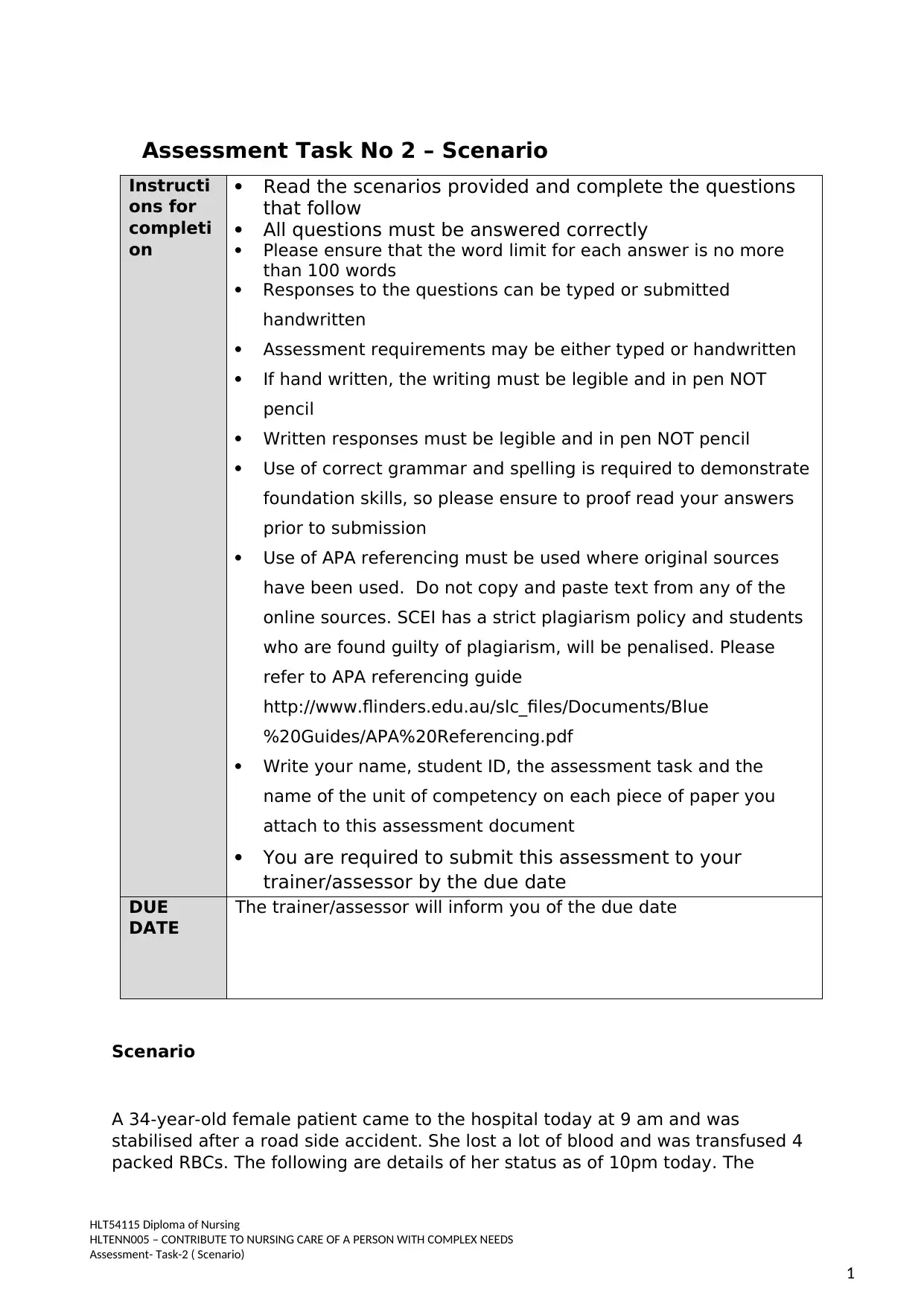
Student
Assessment
Assessment Task No 2 – Scenario
Instructi
ons for
completi
on
Read the scenarios provided and complete the questions
that follow
All questions must be answered correctly
Please ensure that the word limit for each answer is no more
than 100 words
Responses to the questions can be typed or submitted
handwritten
Assessment requirements may be either typed or handwritten
If hand written, the writing must be legible and in pen NOT
pencil
Written responses must be legible and in pen NOT pencil
Use of correct grammar and spelling is required to demonstrate
foundation skills, so please ensure to proof read your answers
prior to submission
Use of APA referencing must be used where original sources
have been used. Do not copy and paste text from any of the
online sources. SCEI has a strict plagiarism policy and students
who are found guilty of plagiarism, will be penalised. Please
refer to APA referencing guide
http://www.flinders.edu.au/slc_files/Documents/Blue
%20Guides/APA%20Referencing.pdf
Write your name, student ID, the assessment task and the
name of the unit of competency on each piece of paper you
attach to this assessment document
You are required to submit this assessment to your
trainer/assessor by the due date
DUE
DATE
The trainer/assessor will inform you of the due date
Scenario
A 34-year-old female patient came to the hospital today at 9 am and was
stabilised after a road side accident. She lost a lot of blood and was transfused 4
packed RBCs. The following are details of her status as of 10pm today. The
HLT54115 Diploma of Nursing
HLTENN005 – CONTRIBUTE TO NURSING CARE OF A PERSON WITH COMPLEX NEEDS
Assessment- Task-2 ( Scenario)
1
Assessment
Assessment Task No 2 – Scenario
Instructi
ons for
completi
on
Read the scenarios provided and complete the questions
that follow
All questions must be answered correctly
Please ensure that the word limit for each answer is no more
than 100 words
Responses to the questions can be typed or submitted
handwritten
Assessment requirements may be either typed or handwritten
If hand written, the writing must be legible and in pen NOT
pencil
Written responses must be legible and in pen NOT pencil
Use of correct grammar and spelling is required to demonstrate
foundation skills, so please ensure to proof read your answers
prior to submission
Use of APA referencing must be used where original sources
have been used. Do not copy and paste text from any of the
online sources. SCEI has a strict plagiarism policy and students
who are found guilty of plagiarism, will be penalised. Please
refer to APA referencing guide
http://www.flinders.edu.au/slc_files/Documents/Blue
%20Guides/APA%20Referencing.pdf
Write your name, student ID, the assessment task and the
name of the unit of competency on each piece of paper you
attach to this assessment document
You are required to submit this assessment to your
trainer/assessor by the due date
DUE
DATE
The trainer/assessor will inform you of the due date
Scenario
A 34-year-old female patient came to the hospital today at 9 am and was
stabilised after a road side accident. She lost a lot of blood and was transfused 4
packed RBCs. The following are details of her status as of 10pm today. The
HLT54115 Diploma of Nursing
HLTENN005 – CONTRIBUTE TO NURSING CARE OF A PERSON WITH COMPLEX NEEDS
Assessment- Task-2 ( Scenario)
1
Paraphrase This Document
Need a fresh take? Get an instant paraphrase of this document with our AI Paraphraser
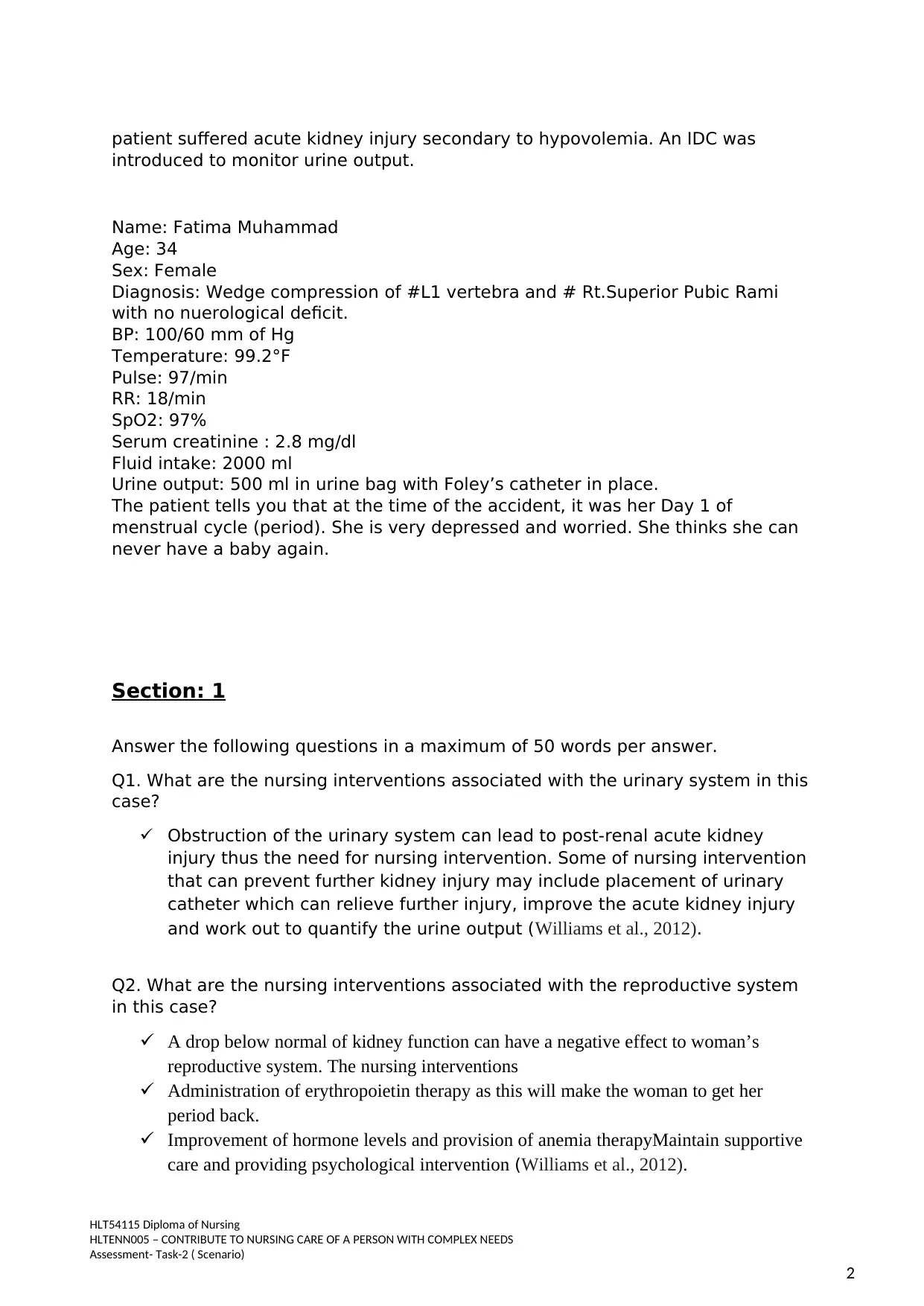
Student
Assessment
patient suffered acute kidney injury secondary to hypovolemia. An IDC was
introduced to monitor urine output.
Name: Fatima Muhammad
Age: 34
Sex: Female
Diagnosis: Wedge compression of #L1 vertebra and # Rt.Superior Pubic Rami
with no nuerological deficit.
BP: 100/60 mm of Hg
Temperature: 99.2°F
Pulse: 97/min
RR: 18/min
SpO2: 97%
Serum creatinine : 2.8 mg/dl
Fluid intake: 2000 ml
Urine output: 500 ml in urine bag with Foley’s catheter in place.
The patient tells you that at the time of the accident, it was her Day 1 of
menstrual cycle (period). She is very depressed and worried. She thinks she can
never have a baby again.
Section: 1
Answer the following questions in a maximum of 50 words per answer.
Q1. What are the nursing interventions associated with the urinary system in this
case?
Obstruction of the urinary system can lead to post-renal acute kidney
injury thus the need for nursing intervention. Some of nursing intervention
that can prevent further kidney injury may include placement of urinary
catheter which can relieve further injury, improve the acute kidney injury
and work out to quantify the urine output (Williams et al., 2012).
Q2. What are the nursing interventions associated with the reproductive system
in this case?
A drop below normal of kidney function can have a negative effect to woman’s
reproductive system. The nursing interventions
Administration of erythropoietin therapy as this will make the woman to get her
period back.
Improvement of hormone levels and provision of anemia therapyMaintain supportive
care and providing psychological intervention (Williams et al., 2012).
HLT54115 Diploma of Nursing
HLTENN005 – CONTRIBUTE TO NURSING CARE OF A PERSON WITH COMPLEX NEEDS
Assessment- Task-2 ( Scenario)
2
Assessment
patient suffered acute kidney injury secondary to hypovolemia. An IDC was
introduced to monitor urine output.
Name: Fatima Muhammad
Age: 34
Sex: Female
Diagnosis: Wedge compression of #L1 vertebra and # Rt.Superior Pubic Rami
with no nuerological deficit.
BP: 100/60 mm of Hg
Temperature: 99.2°F
Pulse: 97/min
RR: 18/min
SpO2: 97%
Serum creatinine : 2.8 mg/dl
Fluid intake: 2000 ml
Urine output: 500 ml in urine bag with Foley’s catheter in place.
The patient tells you that at the time of the accident, it was her Day 1 of
menstrual cycle (period). She is very depressed and worried. She thinks she can
never have a baby again.
Section: 1
Answer the following questions in a maximum of 50 words per answer.
Q1. What are the nursing interventions associated with the urinary system in this
case?
Obstruction of the urinary system can lead to post-renal acute kidney
injury thus the need for nursing intervention. Some of nursing intervention
that can prevent further kidney injury may include placement of urinary
catheter which can relieve further injury, improve the acute kidney injury
and work out to quantify the urine output (Williams et al., 2012).
Q2. What are the nursing interventions associated with the reproductive system
in this case?
A drop below normal of kidney function can have a negative effect to woman’s
reproductive system. The nursing interventions
Administration of erythropoietin therapy as this will make the woman to get her
period back.
Improvement of hormone levels and provision of anemia therapyMaintain supportive
care and providing psychological intervention (Williams et al., 2012).
HLT54115 Diploma of Nursing
HLTENN005 – CONTRIBUTE TO NURSING CARE OF A PERSON WITH COMPLEX NEEDS
Assessment- Task-2 ( Scenario)
2
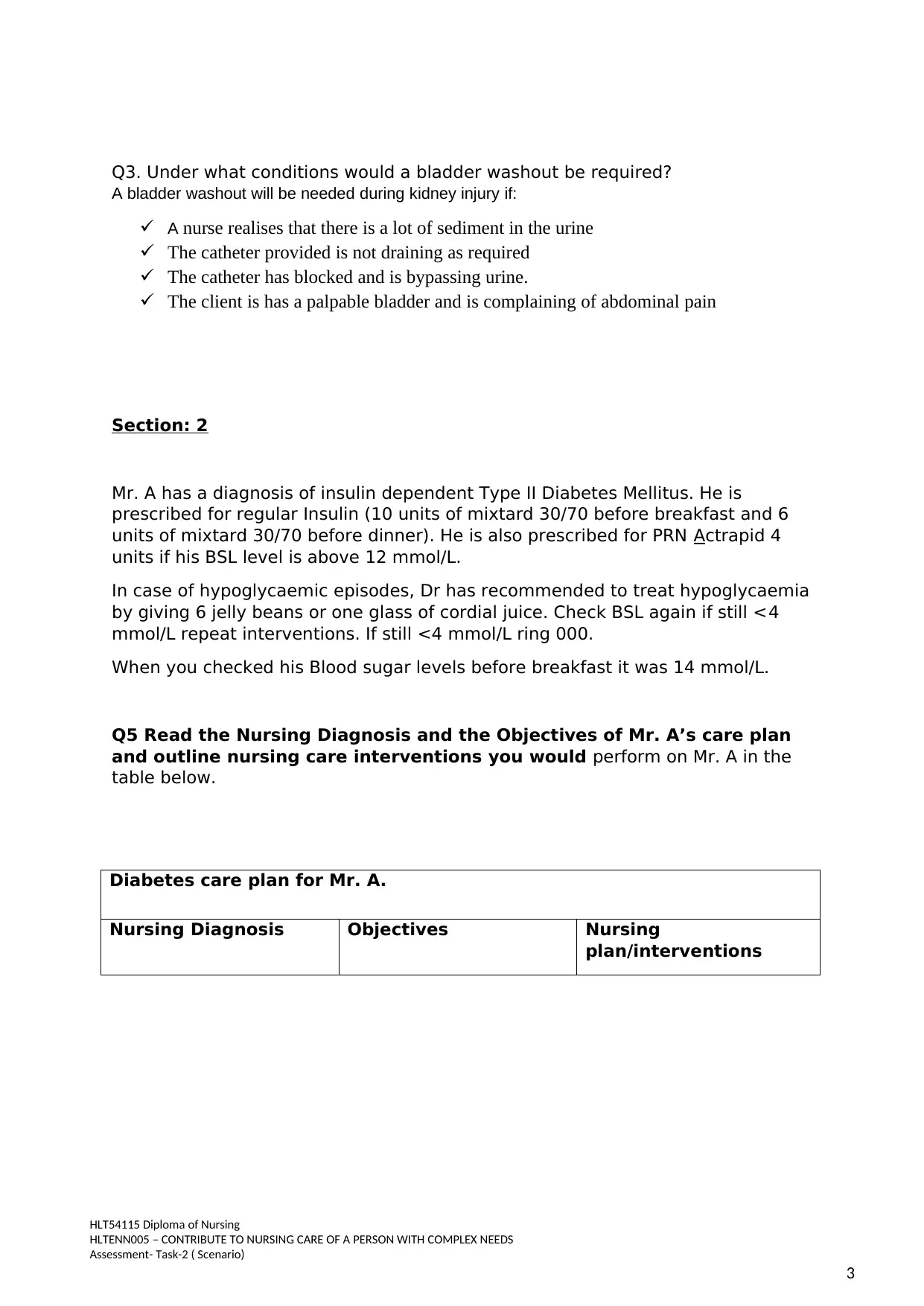
Student
Assessment
Q3. Under what conditions would a bladder washout be required?
A bladder washout will be needed during kidney injury if:
A nurse realises that there is a lot of sediment in the urine
The catheter provided is not draining as required
The catheter has blocked and is bypassing urine.
The client is has a palpable bladder and is complaining of abdominal pain
Section: 2
Mr. A has a diagnosis of insulin dependent Type II Diabetes Mellitus. He is
prescribed for regular Insulin (10 units of mixtard 30/70 before breakfast and 6
units of mixtard 30/70 before dinner). He is also prescribed for PRN Actrapid 4
units if his BSL level is above 12 mmol/L.
In case of hypoglycaemic episodes, Dr has recommended to treat hypoglycaemia
by giving 6 jelly beans or one glass of cordial juice. Check BSL again if still <4
mmol/L repeat interventions. If still <4 mmol/L ring 000.
When you checked his Blood sugar levels before breakfast it was 14 mmol/L.
Q5 Read the Nursing Diagnosis and the Objectives of Mr. A’s care plan
and outline nursing care interventions you would perform on Mr. A in the
table below.
Diabetes care plan for Mr. A.
Nursing Diagnosis Objectives Nursing
plan/interventions
HLT54115 Diploma of Nursing
HLTENN005 – CONTRIBUTE TO NURSING CARE OF A PERSON WITH COMPLEX NEEDS
Assessment- Task-2 ( Scenario)
3
Assessment
Q3. Under what conditions would a bladder washout be required?
A bladder washout will be needed during kidney injury if:
A nurse realises that there is a lot of sediment in the urine
The catheter provided is not draining as required
The catheter has blocked and is bypassing urine.
The client is has a palpable bladder and is complaining of abdominal pain
Section: 2
Mr. A has a diagnosis of insulin dependent Type II Diabetes Mellitus. He is
prescribed for regular Insulin (10 units of mixtard 30/70 before breakfast and 6
units of mixtard 30/70 before dinner). He is also prescribed for PRN Actrapid 4
units if his BSL level is above 12 mmol/L.
In case of hypoglycaemic episodes, Dr has recommended to treat hypoglycaemia
by giving 6 jelly beans or one glass of cordial juice. Check BSL again if still <4
mmol/L repeat interventions. If still <4 mmol/L ring 000.
When you checked his Blood sugar levels before breakfast it was 14 mmol/L.
Q5 Read the Nursing Diagnosis and the Objectives of Mr. A’s care plan
and outline nursing care interventions you would perform on Mr. A in the
table below.
Diabetes care plan for Mr. A.
Nursing Diagnosis Objectives Nursing
plan/interventions
HLT54115 Diploma of Nursing
HLTENN005 – CONTRIBUTE TO NURSING CARE OF A PERSON WITH COMPLEX NEEDS
Assessment- Task-2 ( Scenario)
3
⊘ This is a preview!⊘
Do you want full access?
Subscribe today to unlock all pages.

Trusted by 1+ million students worldwide
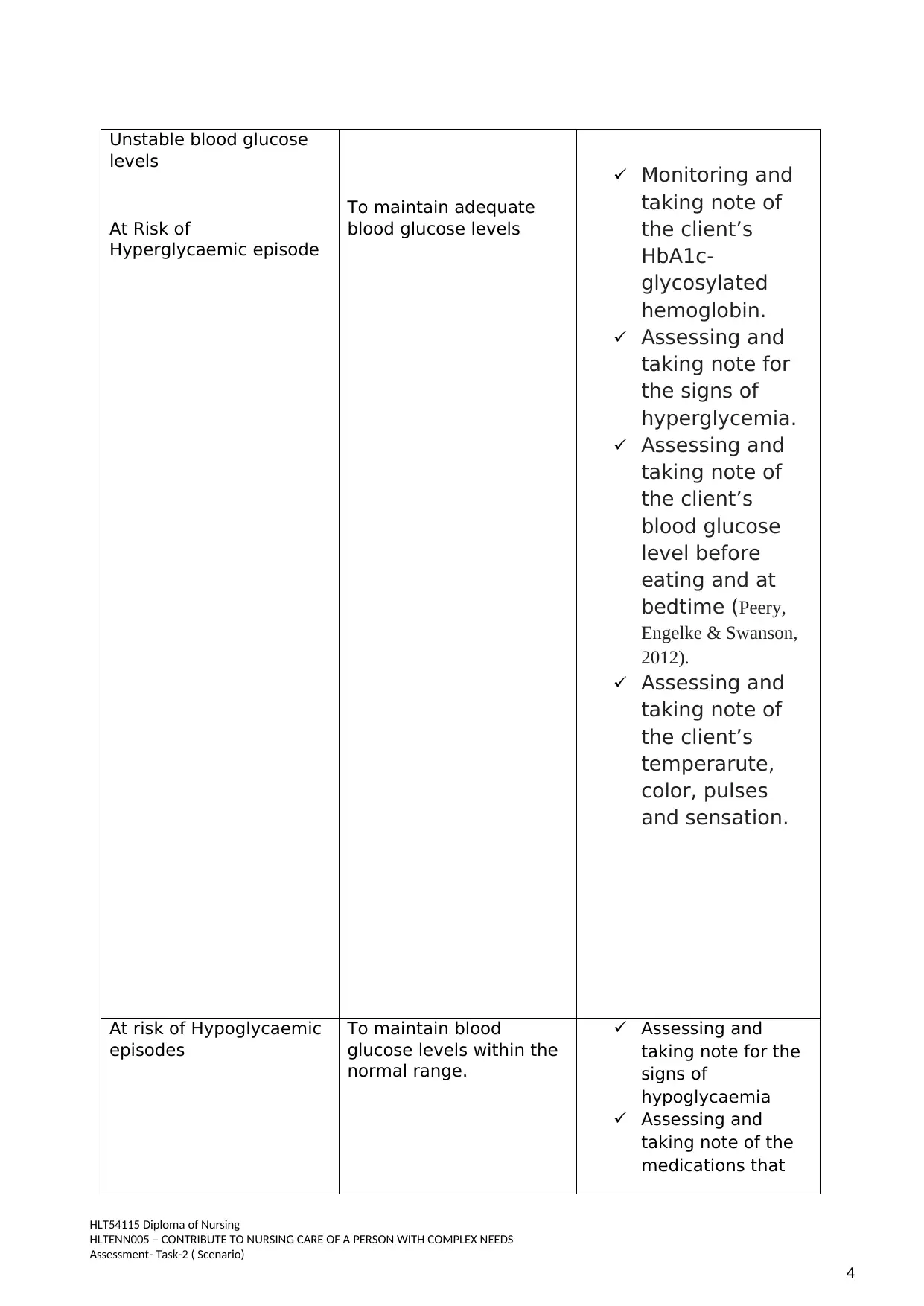
Student
Assessment
Unstable blood glucose
levels
At Risk of
Hyperglycaemic episode
To maintain adequate
blood glucose levels
Monitoring and
taking note of
the client’s
HbA1c-
glycosylated
hemoglobin.
Assessing and
taking note for
the signs of
hyperglycemia.
Assessing and
taking note of
the client’s
blood glucose
level before
eating and at
bedtime (Peery,
Engelke & Swanson,
2012).
Assessing and
taking note of
the client’s
temperarute,
color, pulses
and sensation.
At risk of Hypoglycaemic
episodes
To maintain blood
glucose levels within the
normal range.
Assessing and
taking note for the
signs of
hypoglycaemia
Assessing and
taking note of the
medications that
HLT54115 Diploma of Nursing
HLTENN005 – CONTRIBUTE TO NURSING CARE OF A PERSON WITH COMPLEX NEEDS
Assessment- Task-2 ( Scenario)
4
Assessment
Unstable blood glucose
levels
At Risk of
Hyperglycaemic episode
To maintain adequate
blood glucose levels
Monitoring and
taking note of
the client’s
HbA1c-
glycosylated
hemoglobin.
Assessing and
taking note for
the signs of
hyperglycemia.
Assessing and
taking note of
the client’s
blood glucose
level before
eating and at
bedtime (Peery,
Engelke & Swanson,
2012).
Assessing and
taking note of
the client’s
temperarute,
color, pulses
and sensation.
At risk of Hypoglycaemic
episodes
To maintain blood
glucose levels within the
normal range.
Assessing and
taking note for the
signs of
hypoglycaemia
Assessing and
taking note of the
medications that
HLT54115 Diploma of Nursing
HLTENN005 – CONTRIBUTE TO NURSING CARE OF A PERSON WITH COMPLEX NEEDS
Assessment- Task-2 ( Scenario)
4
Paraphrase This Document
Need a fresh take? Get an instant paraphrase of this document with our AI Paraphraser
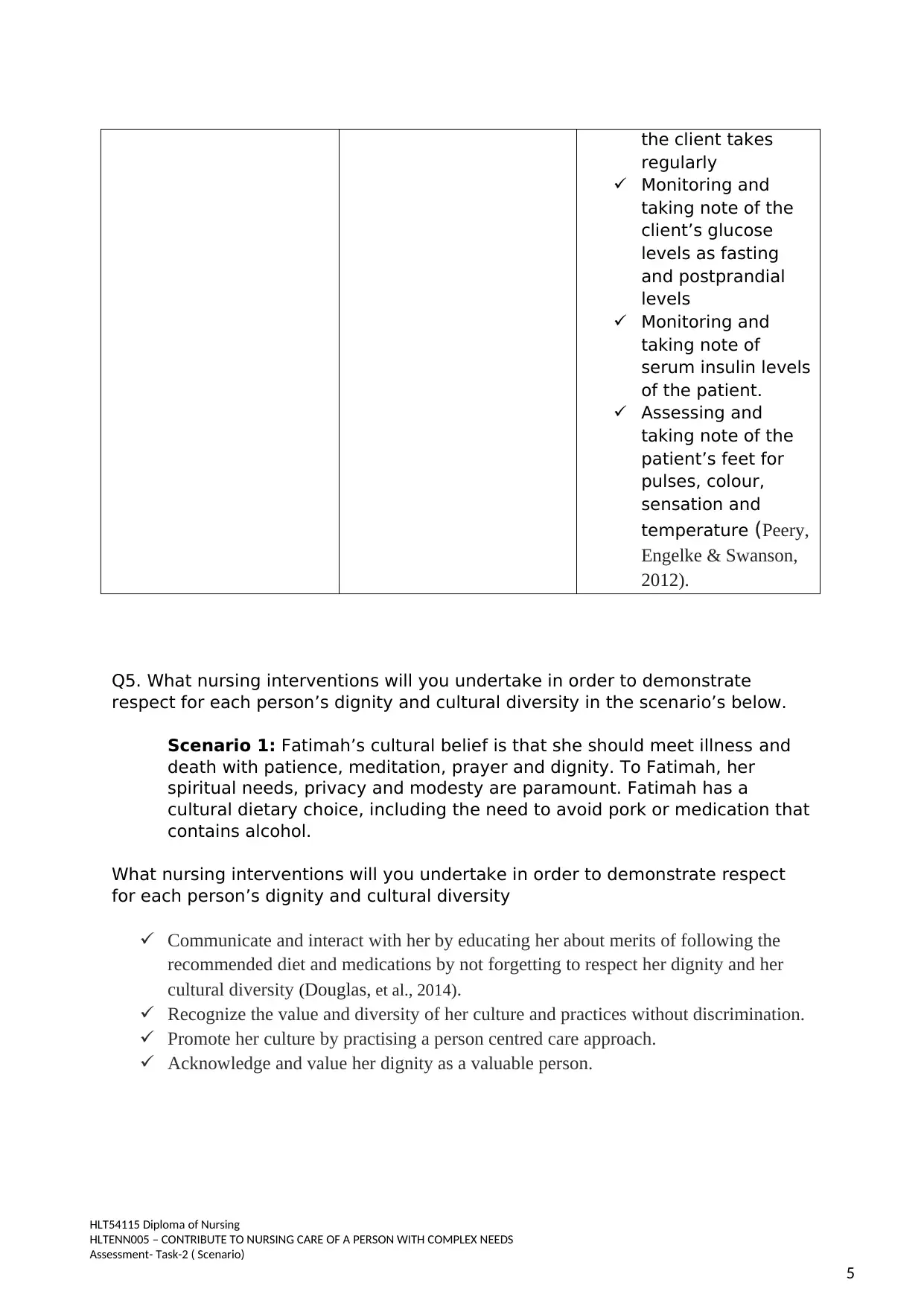
Student
Assessment
the client takes
regularly
Monitoring and
taking note of the
client’s glucose
levels as fasting
and postprandial
levels
Monitoring and
taking note of
serum insulin levels
of the patient.
Assessing and
taking note of the
patient’s feet for
pulses, colour,
sensation and
temperature (Peery,
Engelke & Swanson,
2012).
Q5. What nursing interventions will you undertake in order to demonstrate
respect for each person’s dignity and cultural diversity in the scenario’s below.
Scenario 1: Fatimah’s cultural belief is that she should meet illness and
death with patience, meditation, prayer and dignity. To Fatimah, her
spiritual needs, privacy and modesty are paramount. Fatimah has a
cultural dietary choice, including the need to avoid pork or medication that
contains alcohol.
What nursing interventions will you undertake in order to demonstrate respect
for each person’s dignity and cultural diversity
Communicate and interact with her by educating her about merits of following the
recommended diet and medications by not forgetting to respect her dignity and her
cultural diversity (Douglas, et al., 2014).
Recognize the value and diversity of her culture and practices without discrimination.
Promote her culture by practising a person centred care approach.
Acknowledge and value her dignity as a valuable person.
HLT54115 Diploma of Nursing
HLTENN005 – CONTRIBUTE TO NURSING CARE OF A PERSON WITH COMPLEX NEEDS
Assessment- Task-2 ( Scenario)
5
Assessment
the client takes
regularly
Monitoring and
taking note of the
client’s glucose
levels as fasting
and postprandial
levels
Monitoring and
taking note of
serum insulin levels
of the patient.
Assessing and
taking note of the
patient’s feet for
pulses, colour,
sensation and
temperature (Peery,
Engelke & Swanson,
2012).
Q5. What nursing interventions will you undertake in order to demonstrate
respect for each person’s dignity and cultural diversity in the scenario’s below.
Scenario 1: Fatimah’s cultural belief is that she should meet illness and
death with patience, meditation, prayer and dignity. To Fatimah, her
spiritual needs, privacy and modesty are paramount. Fatimah has a
cultural dietary choice, including the need to avoid pork or medication that
contains alcohol.
What nursing interventions will you undertake in order to demonstrate respect
for each person’s dignity and cultural diversity
Communicate and interact with her by educating her about merits of following the
recommended diet and medications by not forgetting to respect her dignity and her
cultural diversity (Douglas, et al., 2014).
Recognize the value and diversity of her culture and practices without discrimination.
Promote her culture by practising a person centred care approach.
Acknowledge and value her dignity as a valuable person.
HLT54115 Diploma of Nursing
HLTENN005 – CONTRIBUTE TO NURSING CARE OF A PERSON WITH COMPLEX NEEDS
Assessment- Task-2 ( Scenario)
5
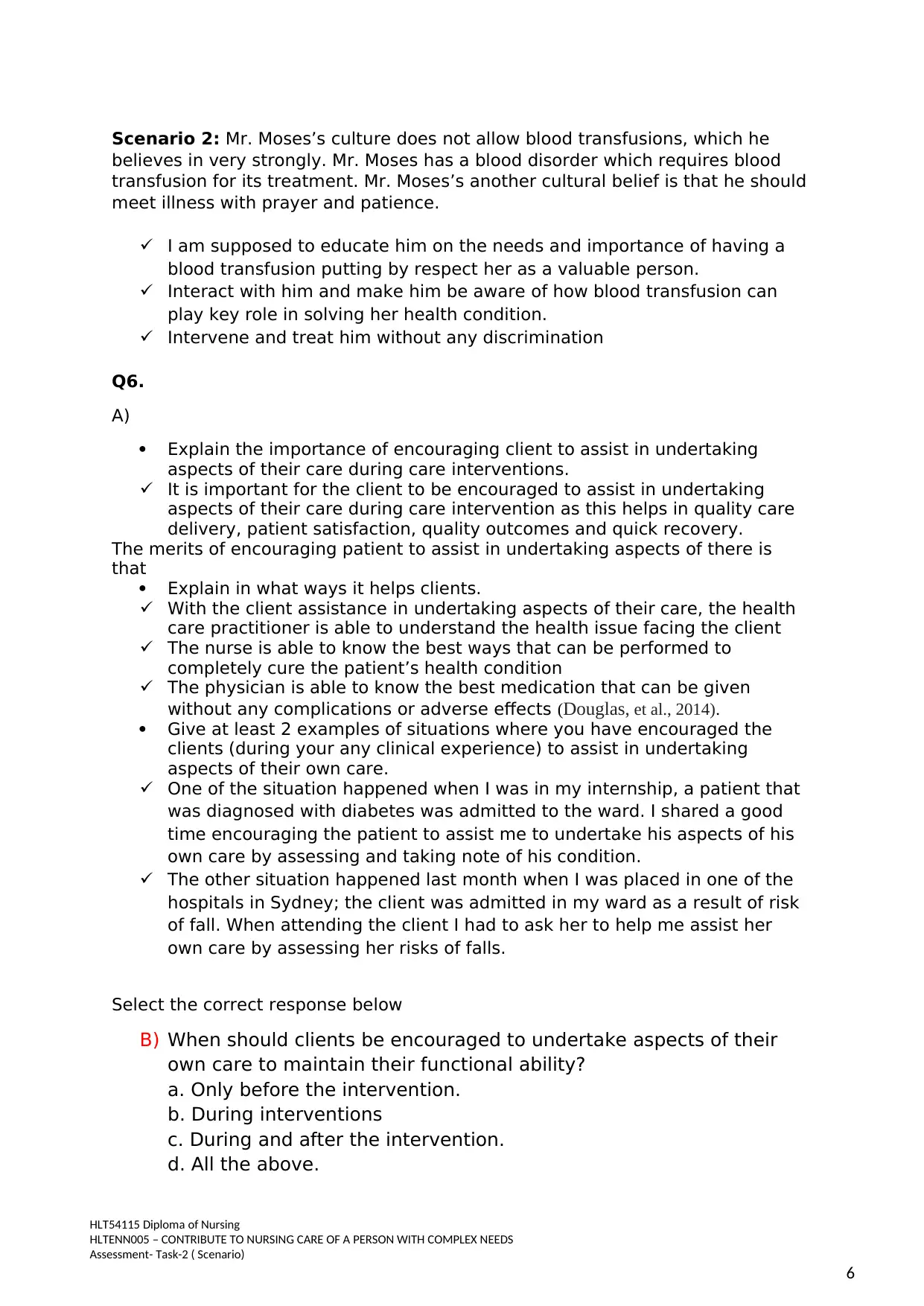
Student
Assessment
Scenario 2: Mr. Moses’s culture does not allow blood transfusions, which he
believes in very strongly. Mr. Moses has a blood disorder which requires blood
transfusion for its treatment. Mr. Moses’s another cultural belief is that he should
meet illness with prayer and patience.
I am supposed to educate him on the needs and importance of having a
blood transfusion putting by respect her as a valuable person.
Interact with him and make him be aware of how blood transfusion can
play key role in solving her health condition.
Intervene and treat him without any discrimination
Q6.
A)
Explain the importance of encouraging client to assist in undertaking
aspects of their care during care interventions.
It is important for the client to be encouraged to assist in undertaking
aspects of their care during care intervention as this helps in quality care
delivery, patient satisfaction, quality outcomes and quick recovery.
The merits of encouraging patient to assist in undertaking aspects of there is
that
Explain in what ways it helps clients.
With the client assistance in undertaking aspects of their care, the health
care practitioner is able to understand the health issue facing the client
The nurse is able to know the best ways that can be performed to
completely cure the patient’s health condition
The physician is able to know the best medication that can be given
without any complications or adverse effects (Douglas, et al., 2014).
Give at least 2 examples of situations where you have encouraged the
clients (during your any clinical experience) to assist in undertaking
aspects of their own care.
One of the situation happened when I was in my internship, a patient that
was diagnosed with diabetes was admitted to the ward. I shared a good
time encouraging the patient to assist me to undertake his aspects of his
own care by assessing and taking note of his condition.
The other situation happened last month when I was placed in one of the
hospitals in Sydney; the client was admitted in my ward as a result of risk
of fall. When attending the client I had to ask her to help me assist her
own care by assessing her risks of falls.
Select the correct response below
B) When should clients be encouraged to undertake aspects of their
own care to maintain their functional ability?
a. Only before the intervention.
b. During interventions
c. During and after the intervention.
d. All the above.
HLT54115 Diploma of Nursing
HLTENN005 – CONTRIBUTE TO NURSING CARE OF A PERSON WITH COMPLEX NEEDS
Assessment- Task-2 ( Scenario)
6
Assessment
Scenario 2: Mr. Moses’s culture does not allow blood transfusions, which he
believes in very strongly. Mr. Moses has a blood disorder which requires blood
transfusion for its treatment. Mr. Moses’s another cultural belief is that he should
meet illness with prayer and patience.
I am supposed to educate him on the needs and importance of having a
blood transfusion putting by respect her as a valuable person.
Interact with him and make him be aware of how blood transfusion can
play key role in solving her health condition.
Intervene and treat him without any discrimination
Q6.
A)
Explain the importance of encouraging client to assist in undertaking
aspects of their care during care interventions.
It is important for the client to be encouraged to assist in undertaking
aspects of their care during care intervention as this helps in quality care
delivery, patient satisfaction, quality outcomes and quick recovery.
The merits of encouraging patient to assist in undertaking aspects of there is
that
Explain in what ways it helps clients.
With the client assistance in undertaking aspects of their care, the health
care practitioner is able to understand the health issue facing the client
The nurse is able to know the best ways that can be performed to
completely cure the patient’s health condition
The physician is able to know the best medication that can be given
without any complications or adverse effects (Douglas, et al., 2014).
Give at least 2 examples of situations where you have encouraged the
clients (during your any clinical experience) to assist in undertaking
aspects of their own care.
One of the situation happened when I was in my internship, a patient that
was diagnosed with diabetes was admitted to the ward. I shared a good
time encouraging the patient to assist me to undertake his aspects of his
own care by assessing and taking note of his condition.
The other situation happened last month when I was placed in one of the
hospitals in Sydney; the client was admitted in my ward as a result of risk
of fall. When attending the client I had to ask her to help me assist her
own care by assessing her risks of falls.
Select the correct response below
B) When should clients be encouraged to undertake aspects of their
own care to maintain their functional ability?
a. Only before the intervention.
b. During interventions
c. During and after the intervention.
d. All the above.
HLT54115 Diploma of Nursing
HLTENN005 – CONTRIBUTE TO NURSING CARE OF A PERSON WITH COMPLEX NEEDS
Assessment- Task-2 ( Scenario)
6
⊘ This is a preview!⊘
Do you want full access?
Subscribe today to unlock all pages.

Trusted by 1+ million students worldwide
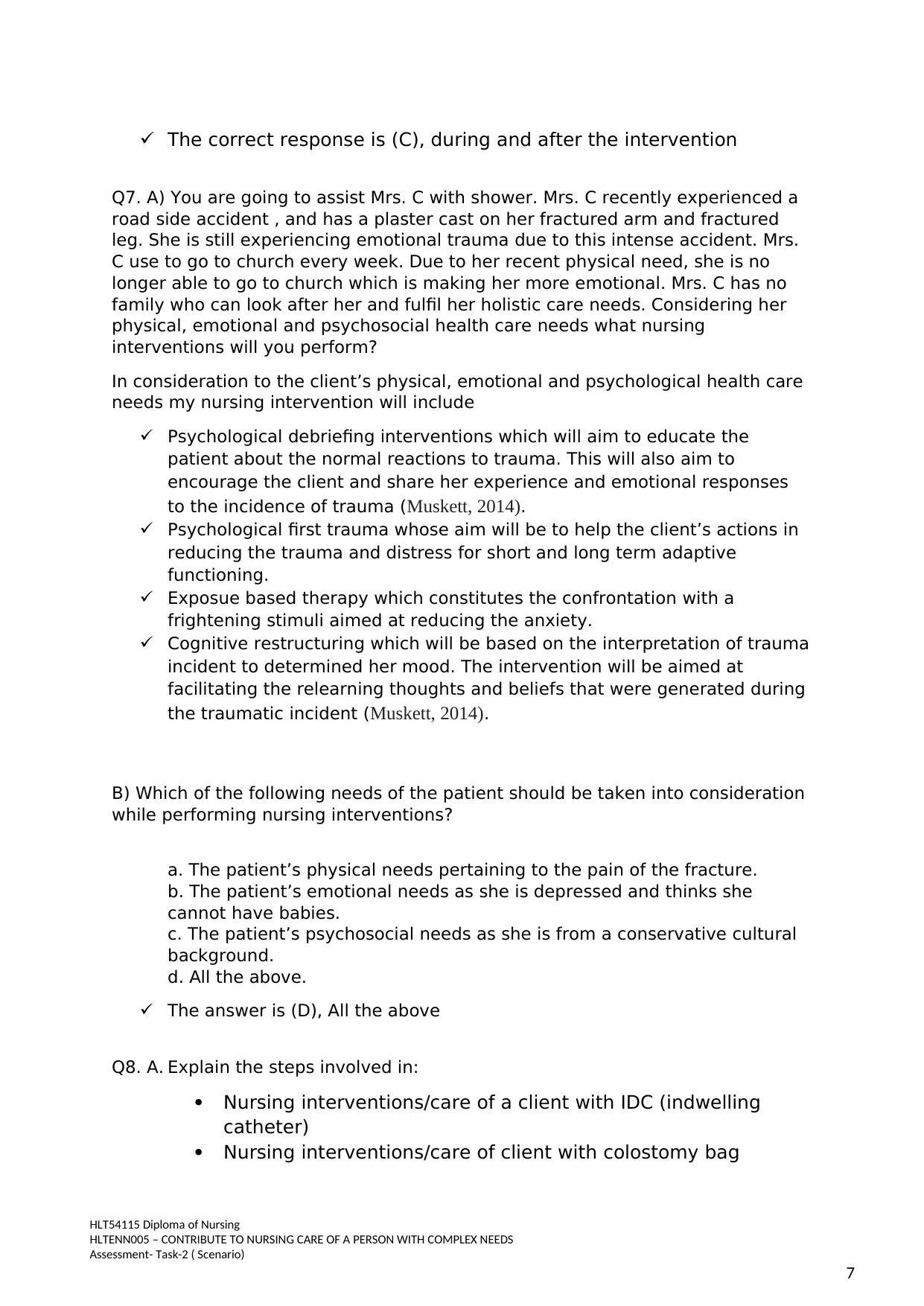
Student
Assessment
The correct response is (C), during and after the intervention
Q7. A) You are going to assist Mrs. C with shower. Mrs. C recently experienced a
road side accident , and has a plaster cast on her fractured arm and fractured
leg. She is still experiencing emotional trauma due to this intense accident. Mrs.
C use to go to church every week. Due to her recent physical need, she is no
longer able to go to church which is making her more emotional. Mrs. C has no
family who can look after her and fulfil her holistic care needs. Considering her
physical, emotional and psychosocial health care needs what nursing
interventions will you perform?
In consideration to the client’s physical, emotional and psychological health care
needs my nursing intervention will include
Psychological debriefing interventions which will aim to educate the
patient about the normal reactions to trauma. This will also aim to
encourage the client and share her experience and emotional responses
to the incidence of trauma (Muskett, 2014).
Psychological first trauma whose aim will be to help the client’s actions in
reducing the trauma and distress for short and long term adaptive
functioning.
Exposue based therapy which constitutes the confrontation with a
frightening stimuli aimed at reducing the anxiety.
Cognitive restructuring which will be based on the interpretation of trauma
incident to determined her mood. The intervention will be aimed at
facilitating the relearning thoughts and beliefs that were generated during
the traumatic incident (Muskett, 2014).
B) Which of the following needs of the patient should be taken into consideration
while performing nursing interventions?
a. The patient’s physical needs pertaining to the pain of the fracture.
b. The patient’s emotional needs as she is depressed and thinks she
cannot have babies.
c. The patient’s psychosocial needs as she is from a conservative cultural
background.
d. All the above.
The answer is (D), All the above
Q8. A. Explain the steps involved in:
Nursing interventions/care of a client with IDC (indwelling
catheter)
Nursing interventions/care of client with colostomy bag
HLT54115 Diploma of Nursing
HLTENN005 – CONTRIBUTE TO NURSING CARE OF A PERSON WITH COMPLEX NEEDS
Assessment- Task-2 ( Scenario)
7
Assessment
The correct response is (C), during and after the intervention
Q7. A) You are going to assist Mrs. C with shower. Mrs. C recently experienced a
road side accident , and has a plaster cast on her fractured arm and fractured
leg. She is still experiencing emotional trauma due to this intense accident. Mrs.
C use to go to church every week. Due to her recent physical need, she is no
longer able to go to church which is making her more emotional. Mrs. C has no
family who can look after her and fulfil her holistic care needs. Considering her
physical, emotional and psychosocial health care needs what nursing
interventions will you perform?
In consideration to the client’s physical, emotional and psychological health care
needs my nursing intervention will include
Psychological debriefing interventions which will aim to educate the
patient about the normal reactions to trauma. This will also aim to
encourage the client and share her experience and emotional responses
to the incidence of trauma (Muskett, 2014).
Psychological first trauma whose aim will be to help the client’s actions in
reducing the trauma and distress for short and long term adaptive
functioning.
Exposue based therapy which constitutes the confrontation with a
frightening stimuli aimed at reducing the anxiety.
Cognitive restructuring which will be based on the interpretation of trauma
incident to determined her mood. The intervention will be aimed at
facilitating the relearning thoughts and beliefs that were generated during
the traumatic incident (Muskett, 2014).
B) Which of the following needs of the patient should be taken into consideration
while performing nursing interventions?
a. The patient’s physical needs pertaining to the pain of the fracture.
b. The patient’s emotional needs as she is depressed and thinks she
cannot have babies.
c. The patient’s psychosocial needs as she is from a conservative cultural
background.
d. All the above.
The answer is (D), All the above
Q8. A. Explain the steps involved in:
Nursing interventions/care of a client with IDC (indwelling
catheter)
Nursing interventions/care of client with colostomy bag
HLT54115 Diploma of Nursing
HLTENN005 – CONTRIBUTE TO NURSING CARE OF A PERSON WITH COMPLEX NEEDS
Assessment- Task-2 ( Scenario)
7
Paraphrase This Document
Need a fresh take? Get an instant paraphrase of this document with our AI Paraphraser
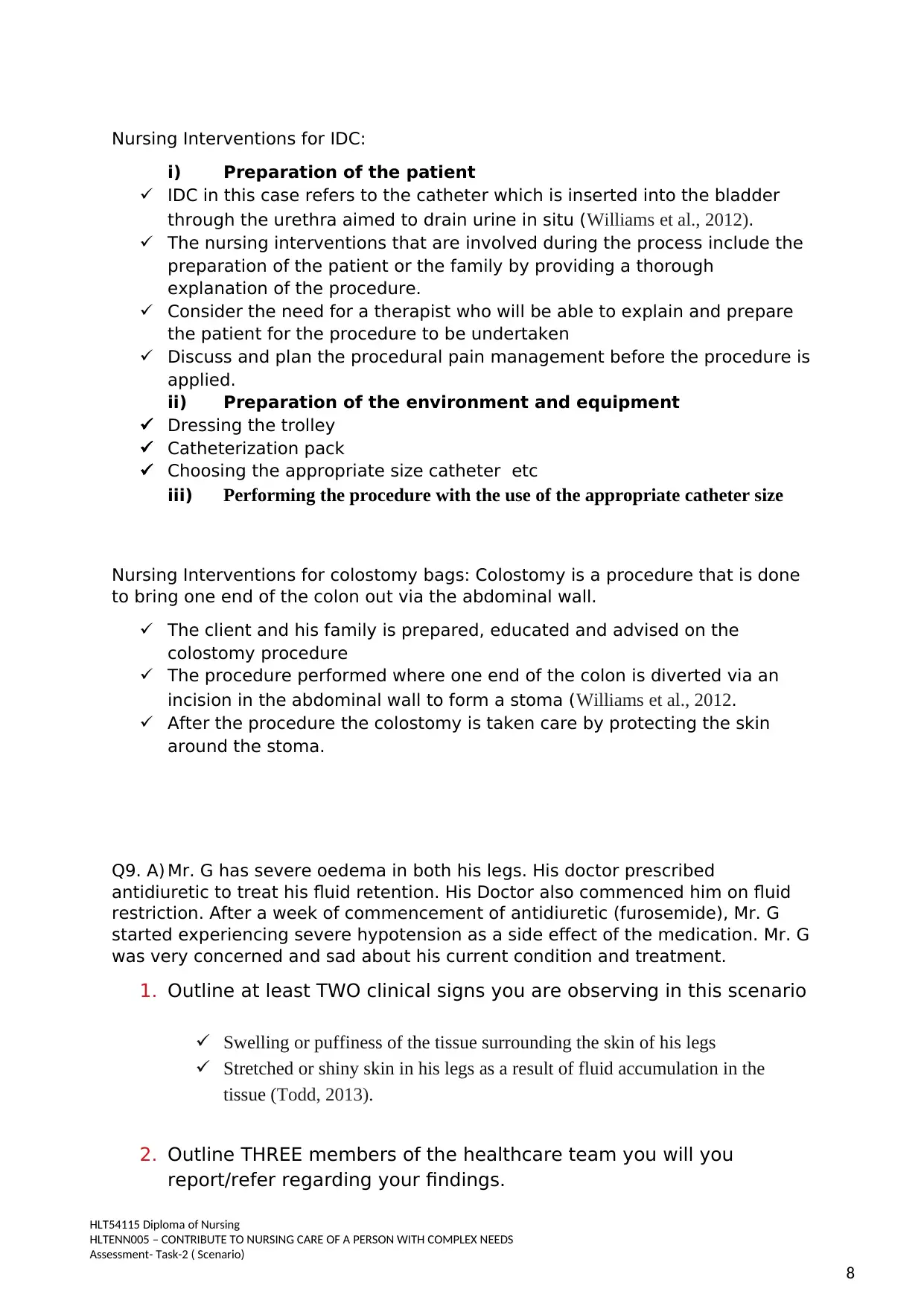
Student
Assessment
Nursing Interventions for IDC:
i) Preparation of the patient
IDC in this case refers to the catheter which is inserted into the bladder
through the urethra aimed to drain urine in situ (Williams et al., 2012).
The nursing interventions that are involved during the process include the
preparation of the patient or the family by providing a thorough
explanation of the procedure.
Consider the need for a therapist who will be able to explain and prepare
the patient for the procedure to be undertaken
Discuss and plan the procedural pain management before the procedure is
applied.
ii) Preparation of the environment and equipment
Dressing the trolley
Catheterization pack
Choosing the appropriate size catheter etc
iii) Performing the procedure with the use of the appropriate catheter size
Nursing Interventions for colostomy bags: Colostomy is a procedure that is done
to bring one end of the colon out via the abdominal wall.
The client and his family is prepared, educated and advised on the
colostomy procedure
The procedure performed where one end of the colon is diverted via an
incision in the abdominal wall to form a stoma (Williams et al., 2012.
After the procedure the colostomy is taken care by protecting the skin
around the stoma.
Q9. A) Mr. G has severe oedema in both his legs. His doctor prescribed
antidiuretic to treat his fluid retention. His Doctor also commenced him on fluid
restriction. After a week of commencement of antidiuretic (furosemide), Mr. G
started experiencing severe hypotension as a side effect of the medication. Mr. G
was very concerned and sad about his current condition and treatment.
1. Outline at least TWO clinical signs you are observing in this scenario
Swelling or puffiness of the tissue surrounding the skin of his legs
Stretched or shiny skin in his legs as a result of fluid accumulation in the
tissue (Todd, 2013).
2. Outline THREE members of the healthcare team you will you
report/refer regarding your findings.
HLT54115 Diploma of Nursing
HLTENN005 – CONTRIBUTE TO NURSING CARE OF A PERSON WITH COMPLEX NEEDS
Assessment- Task-2 ( Scenario)
8
Assessment
Nursing Interventions for IDC:
i) Preparation of the patient
IDC in this case refers to the catheter which is inserted into the bladder
through the urethra aimed to drain urine in situ (Williams et al., 2012).
The nursing interventions that are involved during the process include the
preparation of the patient or the family by providing a thorough
explanation of the procedure.
Consider the need for a therapist who will be able to explain and prepare
the patient for the procedure to be undertaken
Discuss and plan the procedural pain management before the procedure is
applied.
ii) Preparation of the environment and equipment
Dressing the trolley
Catheterization pack
Choosing the appropriate size catheter etc
iii) Performing the procedure with the use of the appropriate catheter size
Nursing Interventions for colostomy bags: Colostomy is a procedure that is done
to bring one end of the colon out via the abdominal wall.
The client and his family is prepared, educated and advised on the
colostomy procedure
The procedure performed where one end of the colon is diverted via an
incision in the abdominal wall to form a stoma (Williams et al., 2012.
After the procedure the colostomy is taken care by protecting the skin
around the stoma.
Q9. A) Mr. G has severe oedema in both his legs. His doctor prescribed
antidiuretic to treat his fluid retention. His Doctor also commenced him on fluid
restriction. After a week of commencement of antidiuretic (furosemide), Mr. G
started experiencing severe hypotension as a side effect of the medication. Mr. G
was very concerned and sad about his current condition and treatment.
1. Outline at least TWO clinical signs you are observing in this scenario
Swelling or puffiness of the tissue surrounding the skin of his legs
Stretched or shiny skin in his legs as a result of fluid accumulation in the
tissue (Todd, 2013).
2. Outline THREE members of the healthcare team you will you
report/refer regarding your findings.
HLT54115 Diploma of Nursing
HLTENN005 – CONTRIBUTE TO NURSING CARE OF A PERSON WITH COMPLEX NEEDS
Assessment- Task-2 ( Scenario)
8
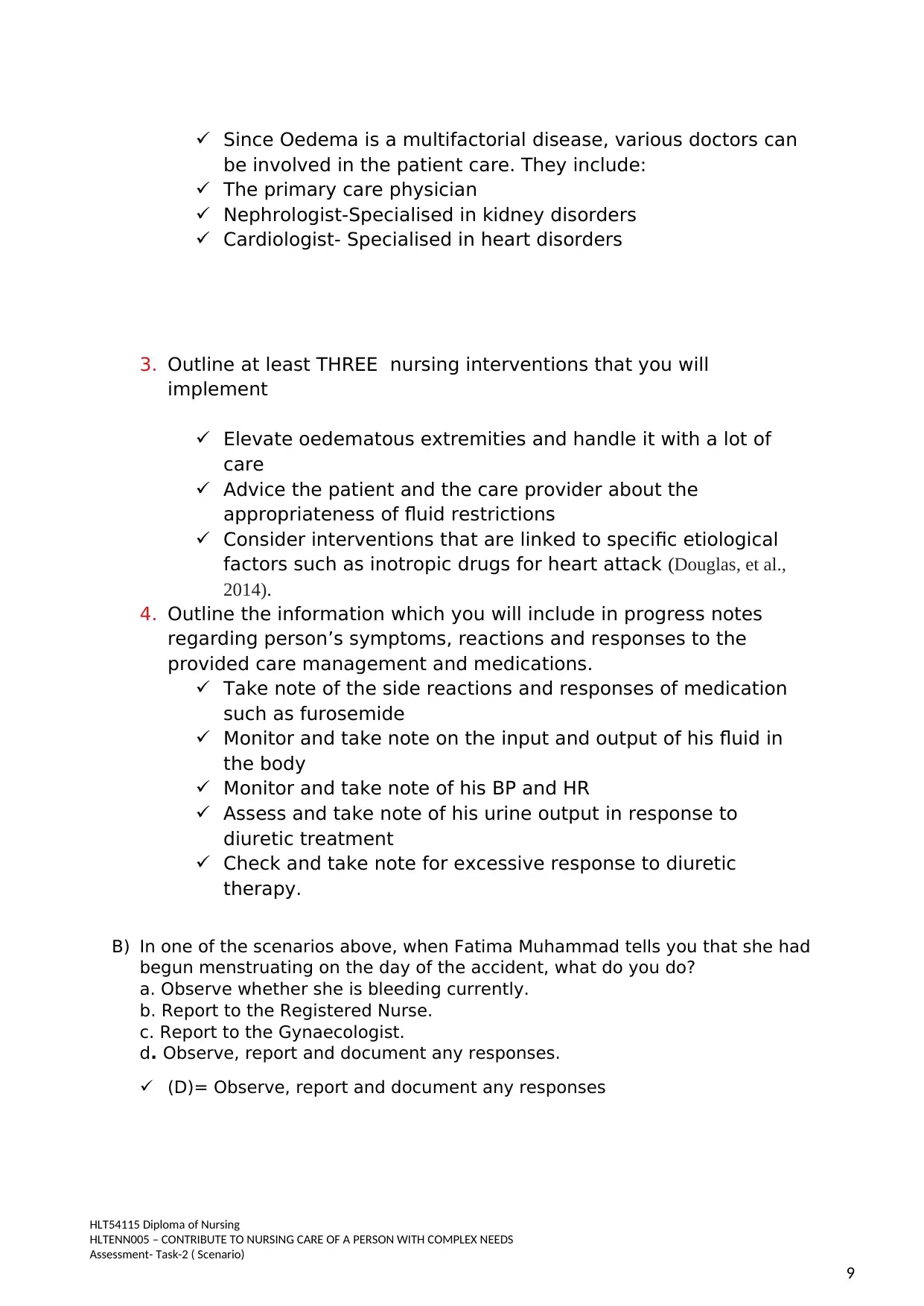
Student
Assessment
Since Oedema is a multifactorial disease, various doctors can
be involved in the patient care. They include:
The primary care physician
Nephrologist-Specialised in kidney disorders
Cardiologist- Specialised in heart disorders
3. Outline at least THREE nursing interventions that you will
implement
Elevate oedematous extremities and handle it with a lot of
care
Advice the patient and the care provider about the
appropriateness of fluid restrictions
Consider interventions that are linked to specific etiological
factors such as inotropic drugs for heart attack (Douglas, et al.,
2014).
4. Outline the information which you will include in progress notes
regarding person’s symptoms, reactions and responses to the
provided care management and medications.
Take note of the side reactions and responses of medication
such as furosemide
Monitor and take note on the input and output of his fluid in
the body
Monitor and take note of his BP and HR
Assess and take note of his urine output in response to
diuretic treatment
Check and take note for excessive response to diuretic
therapy.
B) In one of the scenarios above, when Fatima Muhammad tells you that she had
begun menstruating on the day of the accident, what do you do?
a. Observe whether she is bleeding currently.
b. Report to the Registered Nurse.
c. Report to the Gynaecologist.
d. Observe, report and document any responses.
(D)= Observe, report and document any responses
HLT54115 Diploma of Nursing
HLTENN005 – CONTRIBUTE TO NURSING CARE OF A PERSON WITH COMPLEX NEEDS
Assessment- Task-2 ( Scenario)
9
Assessment
Since Oedema is a multifactorial disease, various doctors can
be involved in the patient care. They include:
The primary care physician
Nephrologist-Specialised in kidney disorders
Cardiologist- Specialised in heart disorders
3. Outline at least THREE nursing interventions that you will
implement
Elevate oedematous extremities and handle it with a lot of
care
Advice the patient and the care provider about the
appropriateness of fluid restrictions
Consider interventions that are linked to specific etiological
factors such as inotropic drugs for heart attack (Douglas, et al.,
2014).
4. Outline the information which you will include in progress notes
regarding person’s symptoms, reactions and responses to the
provided care management and medications.
Take note of the side reactions and responses of medication
such as furosemide
Monitor and take note on the input and output of his fluid in
the body
Monitor and take note of his BP and HR
Assess and take note of his urine output in response to
diuretic treatment
Check and take note for excessive response to diuretic
therapy.
B) In one of the scenarios above, when Fatima Muhammad tells you that she had
begun menstruating on the day of the accident, what do you do?
a. Observe whether she is bleeding currently.
b. Report to the Registered Nurse.
c. Report to the Gynaecologist.
d. Observe, report and document any responses.
(D)= Observe, report and document any responses
HLT54115 Diploma of Nursing
HLTENN005 – CONTRIBUTE TO NURSING CARE OF A PERSON WITH COMPLEX NEEDS
Assessment- Task-2 ( Scenario)
9
⊘ This is a preview!⊘
Do you want full access?
Subscribe today to unlock all pages.

Trusted by 1+ million students worldwide
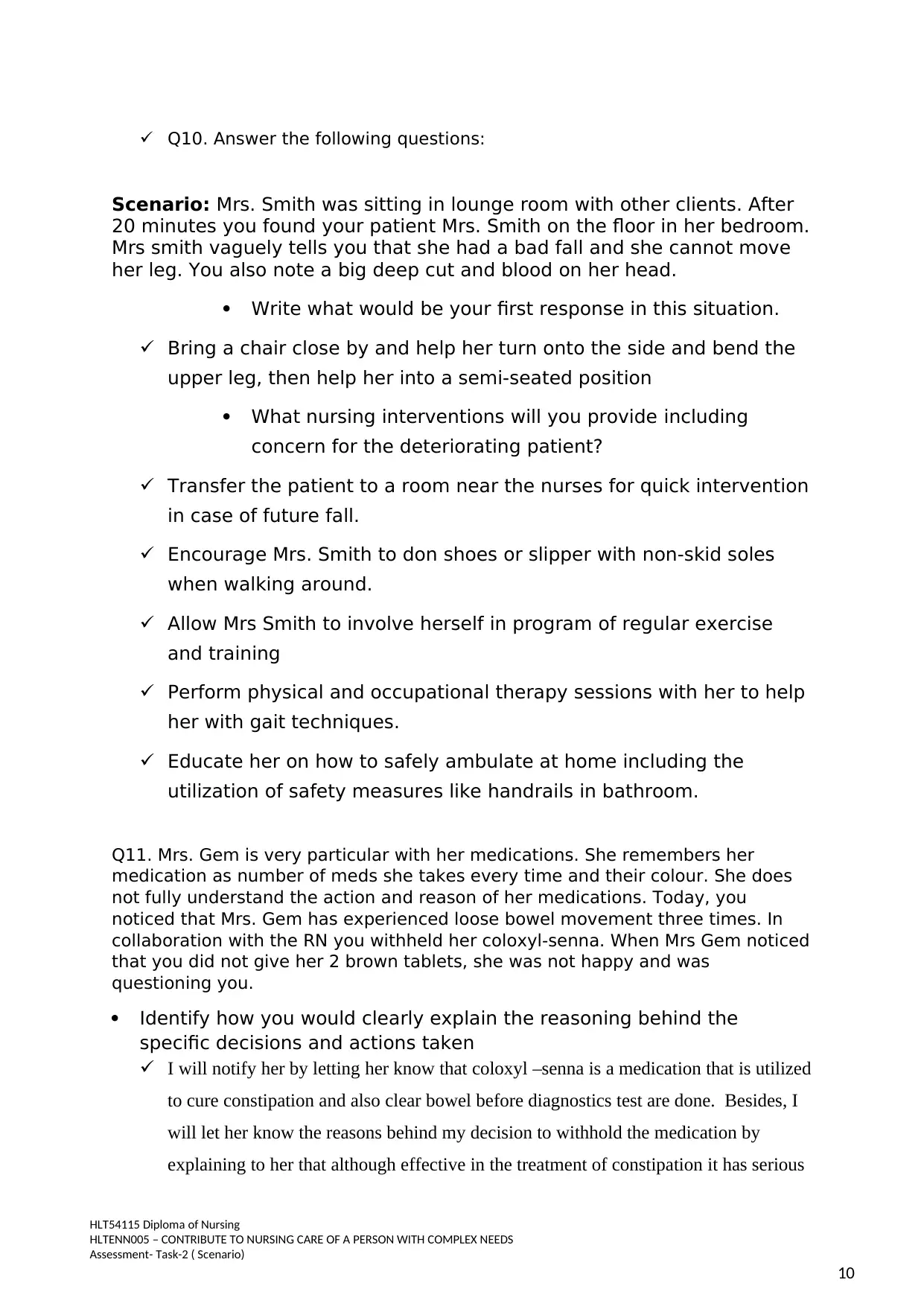
Student
Assessment
Q10. Answer the following questions:
Scenario: Mrs. Smith was sitting in lounge room with other clients. After
20 minutes you found your patient Mrs. Smith on the floor in her bedroom.
Mrs smith vaguely tells you that she had a bad fall and she cannot move
her leg. You also note a big deep cut and blood on her head.
Write what would be your first response in this situation.
Bring a chair close by and help her turn onto the side and bend the
upper leg, then help her into a semi-seated position
What nursing interventions will you provide including
concern for the deteriorating patient?
Transfer the patient to a room near the nurses for quick intervention
in case of future fall.
Encourage Mrs. Smith to don shoes or slipper with non-skid soles
when walking around.
Allow Mrs Smith to involve herself in program of regular exercise
and training
Perform physical and occupational therapy sessions with her to help
her with gait techniques.
Educate her on how to safely ambulate at home including the
utilization of safety measures like handrails in bathroom.
Q11. Mrs. Gem is very particular with her medications. She remembers her
medication as number of meds she takes every time and their colour. She does
not fully understand the action and reason of her medications. Today, you
noticed that Mrs. Gem has experienced loose bowel movement three times. In
collaboration with the RN you withheld her coloxyl-senna. When Mrs Gem noticed
that you did not give her 2 brown tablets, she was not happy and was
questioning you.
Identify how you would clearly explain the reasoning behind the
specific decisions and actions taken
I will notify her by letting her know that coloxyl –senna is a medication that is utilized
to cure constipation and also clear bowel before diagnostics test are done. Besides, I
will let her know the reasons behind my decision to withhold the medication by
explaining to her that although effective in the treatment of constipation it has serious
HLT54115 Diploma of Nursing
HLTENN005 – CONTRIBUTE TO NURSING CARE OF A PERSON WITH COMPLEX NEEDS
Assessment- Task-2 ( Scenario)
10
Assessment
Q10. Answer the following questions:
Scenario: Mrs. Smith was sitting in lounge room with other clients. After
20 minutes you found your patient Mrs. Smith on the floor in her bedroom.
Mrs smith vaguely tells you that she had a bad fall and she cannot move
her leg. You also note a big deep cut and blood on her head.
Write what would be your first response in this situation.
Bring a chair close by and help her turn onto the side and bend the
upper leg, then help her into a semi-seated position
What nursing interventions will you provide including
concern for the deteriorating patient?
Transfer the patient to a room near the nurses for quick intervention
in case of future fall.
Encourage Mrs. Smith to don shoes or slipper with non-skid soles
when walking around.
Allow Mrs Smith to involve herself in program of regular exercise
and training
Perform physical and occupational therapy sessions with her to help
her with gait techniques.
Educate her on how to safely ambulate at home including the
utilization of safety measures like handrails in bathroom.
Q11. Mrs. Gem is very particular with her medications. She remembers her
medication as number of meds she takes every time and their colour. She does
not fully understand the action and reason of her medications. Today, you
noticed that Mrs. Gem has experienced loose bowel movement three times. In
collaboration with the RN you withheld her coloxyl-senna. When Mrs Gem noticed
that you did not give her 2 brown tablets, she was not happy and was
questioning you.
Identify how you would clearly explain the reasoning behind the
specific decisions and actions taken
I will notify her by letting her know that coloxyl –senna is a medication that is utilized
to cure constipation and also clear bowel before diagnostics test are done. Besides, I
will let her know the reasons behind my decision to withhold the medication by
explaining to her that although effective in the treatment of constipation it has serious
HLT54115 Diploma of Nursing
HLTENN005 – CONTRIBUTE TO NURSING CARE OF A PERSON WITH COMPLEX NEEDS
Assessment- Task-2 ( Scenario)
10
Paraphrase This Document
Need a fresh take? Get an instant paraphrase of this document with our AI Paraphraser
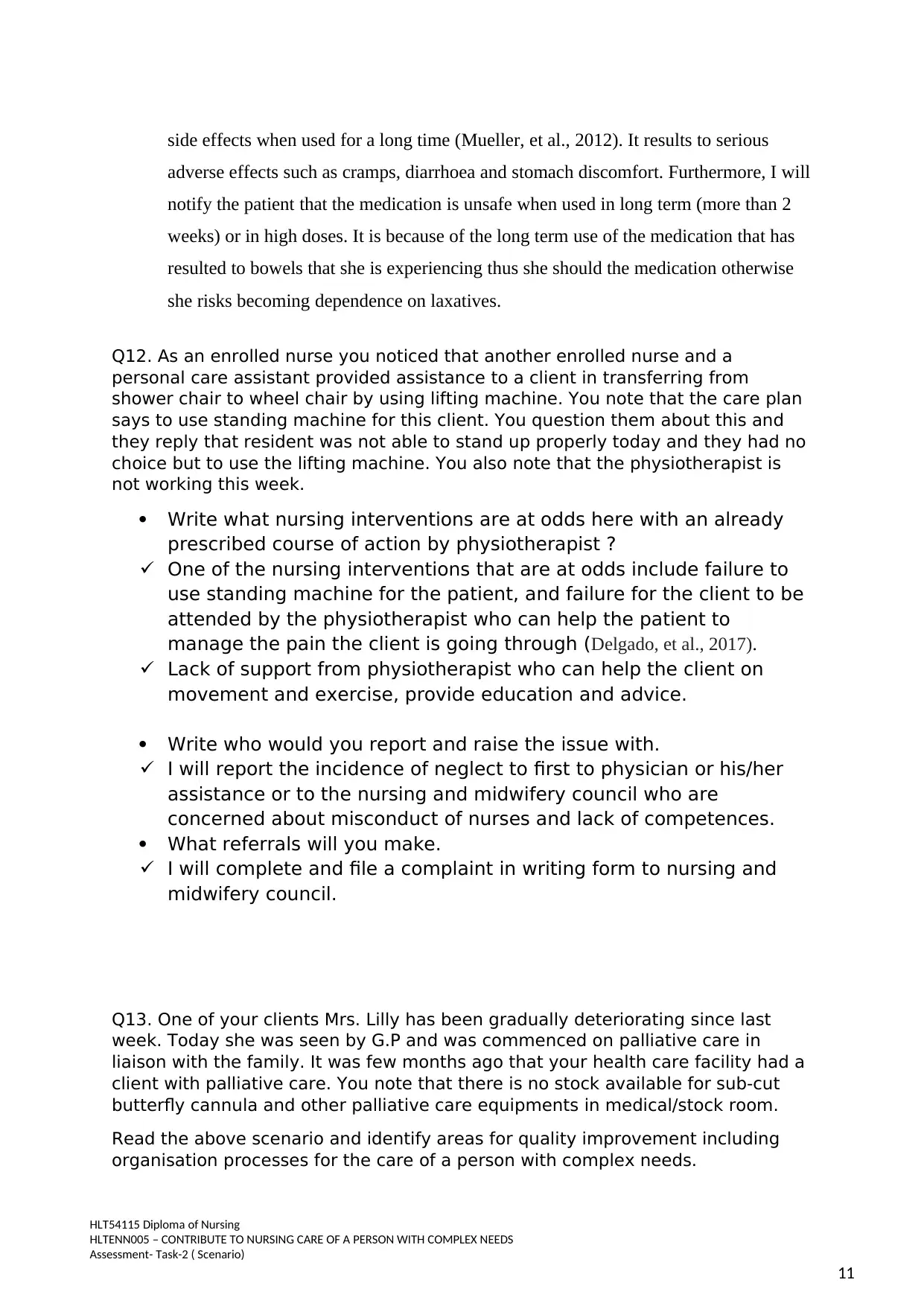
Student
Assessment
side effects when used for a long time (Mueller, et al., 2012). It results to serious
adverse effects such as cramps, diarrhoea and stomach discomfort. Furthermore, I will
notify the patient that the medication is unsafe when used in long term (more than 2
weeks) or in high doses. It is because of the long term use of the medication that has
resulted to bowels that she is experiencing thus she should the medication otherwise
she risks becoming dependence on laxatives.
Q12. As an enrolled nurse you noticed that another enrolled nurse and a
personal care assistant provided assistance to a client in transferring from
shower chair to wheel chair by using lifting machine. You note that the care plan
says to use standing machine for this client. You question them about this and
they reply that resident was not able to stand up properly today and they had no
choice but to use the lifting machine. You also note that the physiotherapist is
not working this week.
Write what nursing interventions are at odds here with an already
prescribed course of action by physiotherapist ?
One of the nursing interventions that are at odds include failure to
use standing machine for the patient, and failure for the client to be
attended by the physiotherapist who can help the patient to
manage the pain the client is going through (Delgado, et al., 2017).
Lack of support from physiotherapist who can help the client on
movement and exercise, provide education and advice.
Write who would you report and raise the issue with.
I will report the incidence of neglect to first to physician or his/her
assistance or to the nursing and midwifery council who are
concerned about misconduct of nurses and lack of competences.
What referrals will you make.
I will complete and file a complaint in writing form to nursing and
midwifery council.
Q13. One of your clients Mrs. Lilly has been gradually deteriorating since last
week. Today she was seen by G.P and was commenced on palliative care in
liaison with the family. It was few months ago that your health care facility had a
client with palliative care. You note that there is no stock available for sub-cut
butterfly cannula and other palliative care equipments in medical/stock room.
Read the above scenario and identify areas for quality improvement including
organisation processes for the care of a person with complex needs.
HLT54115 Diploma of Nursing
HLTENN005 – CONTRIBUTE TO NURSING CARE OF A PERSON WITH COMPLEX NEEDS
Assessment- Task-2 ( Scenario)
11
Assessment
side effects when used for a long time (Mueller, et al., 2012). It results to serious
adverse effects such as cramps, diarrhoea and stomach discomfort. Furthermore, I will
notify the patient that the medication is unsafe when used in long term (more than 2
weeks) or in high doses. It is because of the long term use of the medication that has
resulted to bowels that she is experiencing thus she should the medication otherwise
she risks becoming dependence on laxatives.
Q12. As an enrolled nurse you noticed that another enrolled nurse and a
personal care assistant provided assistance to a client in transferring from
shower chair to wheel chair by using lifting machine. You note that the care plan
says to use standing machine for this client. You question them about this and
they reply that resident was not able to stand up properly today and they had no
choice but to use the lifting machine. You also note that the physiotherapist is
not working this week.
Write what nursing interventions are at odds here with an already
prescribed course of action by physiotherapist ?
One of the nursing interventions that are at odds include failure to
use standing machine for the patient, and failure for the client to be
attended by the physiotherapist who can help the patient to
manage the pain the client is going through (Delgado, et al., 2017).
Lack of support from physiotherapist who can help the client on
movement and exercise, provide education and advice.
Write who would you report and raise the issue with.
I will report the incidence of neglect to first to physician or his/her
assistance or to the nursing and midwifery council who are
concerned about misconduct of nurses and lack of competences.
What referrals will you make.
I will complete and file a complaint in writing form to nursing and
midwifery council.
Q13. One of your clients Mrs. Lilly has been gradually deteriorating since last
week. Today she was seen by G.P and was commenced on palliative care in
liaison with the family. It was few months ago that your health care facility had a
client with palliative care. You note that there is no stock available for sub-cut
butterfly cannula and other palliative care equipments in medical/stock room.
Read the above scenario and identify areas for quality improvement including
organisation processes for the care of a person with complex needs.
HLT54115 Diploma of Nursing
HLTENN005 – CONTRIBUTE TO NURSING CARE OF A PERSON WITH COMPLEX NEEDS
Assessment- Task-2 ( Scenario)
11
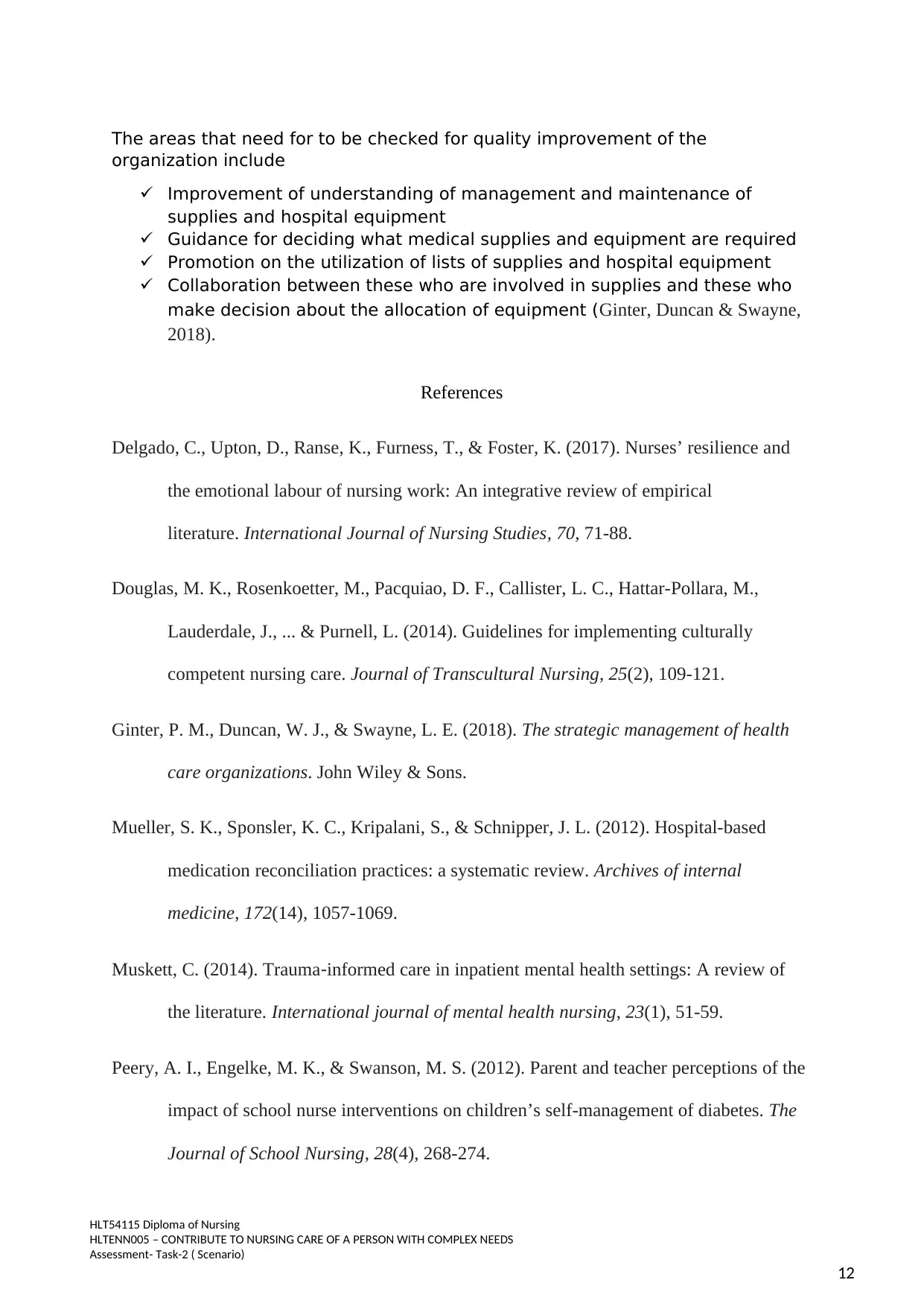
Student
Assessment
The areas that need for to be checked for quality improvement of the
organization include
Improvement of understanding of management and maintenance of
supplies and hospital equipment
Guidance for deciding what medical supplies and equipment are required
Promotion on the utilization of lists of supplies and hospital equipment
Collaboration between these who are involved in supplies and these who
make decision about the allocation of equipment (Ginter, Duncan & Swayne,
2018).
References
Delgado, C., Upton, D., Ranse, K., Furness, T., & Foster, K. (2017). Nurses’ resilience and
the emotional labour of nursing work: An integrative review of empirical
literature. International Journal of Nursing Studies, 70, 71-88.
Douglas, M. K., Rosenkoetter, M., Pacquiao, D. F., Callister, L. C., Hattar-Pollara, M.,
Lauderdale, J., ... & Purnell, L. (2014). Guidelines for implementing culturally
competent nursing care. Journal of Transcultural Nursing, 25(2), 109-121.
Ginter, P. M., Duncan, W. J., & Swayne, L. E. (2018). The strategic management of health
care organizations. John Wiley & Sons.
Mueller, S. K., Sponsler, K. C., Kripalani, S., & Schnipper, J. L. (2012). Hospital-based
medication reconciliation practices: a systematic review. Archives of internal
medicine, 172(14), 1057-1069.
Muskett, C. (2014). Trauma‐informed care in inpatient mental health settings: A review of
the literature. International journal of mental health nursing, 23(1), 51-59.
Peery, A. I., Engelke, M. K., & Swanson, M. S. (2012). Parent and teacher perceptions of the
impact of school nurse interventions on children’s self-management of diabetes. The
Journal of School Nursing, 28(4), 268-274.
HLT54115 Diploma of Nursing
HLTENN005 – CONTRIBUTE TO NURSING CARE OF A PERSON WITH COMPLEX NEEDS
Assessment- Task-2 ( Scenario)
12
Assessment
The areas that need for to be checked for quality improvement of the
organization include
Improvement of understanding of management and maintenance of
supplies and hospital equipment
Guidance for deciding what medical supplies and equipment are required
Promotion on the utilization of lists of supplies and hospital equipment
Collaboration between these who are involved in supplies and these who
make decision about the allocation of equipment (Ginter, Duncan & Swayne,
2018).
References
Delgado, C., Upton, D., Ranse, K., Furness, T., & Foster, K. (2017). Nurses’ resilience and
the emotional labour of nursing work: An integrative review of empirical
literature. International Journal of Nursing Studies, 70, 71-88.
Douglas, M. K., Rosenkoetter, M., Pacquiao, D. F., Callister, L. C., Hattar-Pollara, M.,
Lauderdale, J., ... & Purnell, L. (2014). Guidelines for implementing culturally
competent nursing care. Journal of Transcultural Nursing, 25(2), 109-121.
Ginter, P. M., Duncan, W. J., & Swayne, L. E. (2018). The strategic management of health
care organizations. John Wiley & Sons.
Mueller, S. K., Sponsler, K. C., Kripalani, S., & Schnipper, J. L. (2012). Hospital-based
medication reconciliation practices: a systematic review. Archives of internal
medicine, 172(14), 1057-1069.
Muskett, C. (2014). Trauma‐informed care in inpatient mental health settings: A review of
the literature. International journal of mental health nursing, 23(1), 51-59.
Peery, A. I., Engelke, M. K., & Swanson, M. S. (2012). Parent and teacher perceptions of the
impact of school nurse interventions on children’s self-management of diabetes. The
Journal of School Nursing, 28(4), 268-274.
HLT54115 Diploma of Nursing
HLTENN005 – CONTRIBUTE TO NURSING CARE OF A PERSON WITH COMPLEX NEEDS
Assessment- Task-2 ( Scenario)
12
⊘ This is a preview!⊘
Do you want full access?
Subscribe today to unlock all pages.

Trusted by 1+ million students worldwide
1 out of 13
Related Documents
Your All-in-One AI-Powered Toolkit for Academic Success.
+13062052269
info@desklib.com
Available 24*7 on WhatsApp / Email
![[object Object]](/_next/static/media/star-bottom.7253800d.svg)
Unlock your academic potential
Copyright © 2020–2025 A2Z Services. All Rights Reserved. Developed and managed by ZUCOL.





